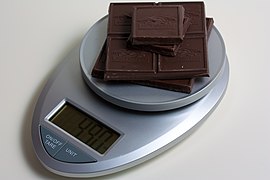Cookbook:Scale
Cookbook | Recipes | Ingredients | Equipment | Techniques | Cookbook Disambiguation Pages | Cookbook equipment
A kitchen scale or balance is a piece of equipment that allows a cook to measure out ingredients by weight instead of by volume. Scales allow for more accuracy and precision than when measuring by volume, especially when measuring out dry ingredients that don't neatly and consistently fit into a measuring cup or spoon.
A scale in the kitchen is essential for more precise recipes. Some recipes, especially in baking, provide measurements in weight instead of volume to compensate for any packing that may have occurred in the ingredient. A small digital scale is the most convenient. Features to look for are:
*Maximum weight the scale should measure. expect 6-10 pounds.
*Minimum weight the scale can accurately measure. .01 oz or .1 g.
*Easily read display
*Weights displayed in imperial or metric values.
*A "zero" button to zero the weight of the container before measuring the ingredient.
*Large flat weighing surface to set a container on.
Types
[edit | edit source]Mechanism
[edit | edit source]A balance scale involves placing a known weight on one side of the scale and enough of the ingredient on the other side to make both sides balanced. A spring scale measures the weight by how much it compresses or stretches a spring.
Readout
[edit | edit source]A scale can either give an analog output, with something like a dial, or a digital output with the precise weight in numbers.
-
Spring-based analog kitchen scale
-
Digital electric scale
-
Balance scale
Selection and maintenance
[edit | edit source]A variety of factors contribute to a good scale. Generally, a scale for home cooks should weigh amounts ranging from 0.125 oz to 4 pounds (1–1800 g), though many basic models can reach up to about 10 pounds. It is also convenient to have a scale that allows the cook to switch between measurements and tare/zero out the reading between ingredients.
The following is a set of tips for proper use and maintenance of a kitchen scale:
- Only use the scale on a flat surface to ensure accurate readings.
- Be aware of the scale's upper weight limit, and avoid going beyond this when using.
- Avoid storing items on top of the scale when not using it, as this can damage the weight sensor.
- If the scale provides the option to do so, calibrate it regularly, following the manufacturer's instructions.
Use
[edit | edit source]Scales provide higher accuracy and precision when measuring ingredients. Large and/or inconsistently-sized ingredients are difficult to fit into volume-measuring utensils like cups and spoons, and powders can be compacted or aerated when measuring, depending on the cook—a weight measurement, however, will always reflect a consistent amount of ingredient. Using a scale is often also less messy, and fewer utensils are required. They easily allow a cook to divide up batters and doughs into even amounts.
External links
[edit | edit source]- https://www.delightedcooking.com/what-is-a-kitchen-scale.htm
- https://www.southernliving.com/food/kitchen-assistant/what-to-use-a-kitchen-scale-for
- https://www.masterclass.com/articles/how-to-use-a-digital-kitchen-scale-benefits-to-cooking-and-baking-with-a-digital-scale
- https://www.seriouseats.com/the-best-kitchen-scales-equipment-review
- https://food52.com/blog/27188-best-kitchen-scales
- https://www.cooksinfo.com/scales
- https://www.thespruceeats.com/best-kitchen-scales-4072911
- https://www.pbs.org/food/fresh-tastes/five-reasons-to-use-a-kitchen-scale/
- https://www.bonappetit.com/story/best-kitchen-scale
- https://www.nytimes.com/wirecutter/reviews/best-kitchen-scale/


